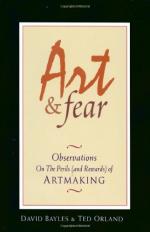
|
| Name: _________________________ | Period: ___________________ |
This test consists of 5 multiple choice questions, 5 short answer questions, and 10 short essay questions.
Multiple Choice Questions
1. Degrees can allow a person to get involved in an art establishment, but this can have a ____________ effect.
(a) Positive.
(b) Energetic.
(c) Rippling.
(d) Corrupting.
2. Artists with great self discipline often can not handle the ______________ others might place on them.
(a) Titles.
(b) Guidelines.
(c) Power.
(d) Restrictions.
3. Newcomer ___________ is often ignored during the hiring process, according to the authors.
(a) Talent.
(b) Enthusiasm.
(c) Reputation.
(d) Skill sets.
4. A crucial problem for many artists is whether to use _____________ tools or to use new ones in art making.
(a) Familiar.
(b) Old.
(c) Innovative.
(d) Modern.
5. Feedback which is received from a piece of art should be something which will __________ an artist, according to the authors.
(a) Downgrade.
(b) Improve.
(c) Energize.
(d) Hurt.
Short Answer Questions
1. __________ often follows a particular plan, albeit sometimes one that takes great skill to achieve, according to the authors.
2. Art is always bound up in what the _____________ desires, according to the authors.
3. Artists will continually use ____________ for their own purposes, with competition being one of these energies.
4. Artists must seek out ___________, publication, and exhibitions in order to spread the word about their art.
5. The __________ line, according to the authors, is the line between one's vision and one's current degree of execution.
Short Essay Questions
1. Why do many artists sometimes have bad reputations in the outside world, according to the authors?
2. What is a problem of having too many focused habits as an artist, according to the authors of this book?
3. What does a true artist always keep in mind when it comes to creating art and about their efforts?
4. What happens to many artists who rely solely on themselves for their art and the motivation for their art?
5. What will the best art do, according to the feeling of the authors at this point of the book?
6. What is the scary thing about art and about what an artist puts into their work?
7. What does an art degree allow an artist to do, according to the authors, even if they do not think it's necessary to make art?
8. Why do many artists dread the idea of being a faculty member at an art school or in an art program?
9. Who understands art the best, according to the authors of the book and their thoughts in this section?
10. What do the problems which occur after a piece of art is made make an artist do?
|
This section contains 619 words (approx. 3 pages at 300 words per page) |

|




